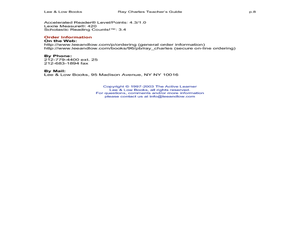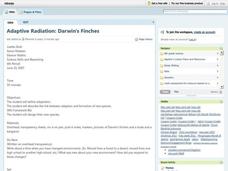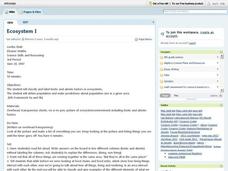Curated OER
Pennies of My Life Part II
Youngsters write and construct their own autobiographies based on The Hundred Penny Box by Sharon Bell Mathis. They engage in pre-writing steps, narrative writing, and peer editing. This is the second part of a two-part project lesson plan.
Curated OER
Through the Years: Language Arts
Second graders read "The Hundred Penny Box" by Sharon Mathis Bell. They research each year of their life in preparation for writing an autobiography and develop notes to help them in later writing.
Curated OER
Lesson 3: Where Does Money Come From?
Learners listen to story Hundred Penny Box by Sharon Bell Mathis, explore history of money, and examine how money is produced in the United States. They discuss why money is used for exchange, and describe how money has changed over time.
Curated OER
Ray Charles
Learners read the book Ray Charles by Sharon Bell Mathis. For this biography instructional activity, students read about the life of Ray Charles. Learners answer pre-reading questions about senses, strengths, and weaknesses they have....
Curated OER
Temperature and Keq
The presentation offers a set of three problems related to temperature and equilibrium reactions. It walks through solving each, reminding pupils how to figure for the forward and reverse rates.
Curated OER
Through the Years
Second graders read "The Hundred Penny Box" by Sharon Bell Mathis. They collect pennies and pictures for each year they have been alive. They use software and their scanned photographs to design an autobiography.
Curated OER
Technology Lesson Plan
Students measure various objects using non-standard units. The goal is for them to practice measuring in order to apply the physical act to various objects found in the classroom. The lesson is ideal for the kinesthetic learners and...
Curated OER
Change From 50p
In this math worksheet, students make change for the different products that are bought at the store using the British Pound.
Curated OER
The Hundred Penny Box
Students compare how people save money in financial institutions, after reading the story, The Hundred Penny Box. They analyze the advantages of regular saving and how savings grow with compounding.
Curated OER
DNA Model
High schoolers are able to construct a candy model of DNA. They are able to list all of the parts of DNA that they investigated earlier. Students are able to describe what each part of DNA does. They create an edible model of DNA...
Curated OER
Reading Chemical Formulas
Students interpret basic chemical formulas. When class begins, students interpret a "chemical formula" for fruit salad. After they interpret the recipe, students use the same strategies to identify chemical formulas. They evaluate the...
Curated OER
Math 1 (Crossword Puzzle)
In this math and language arts worksheet, students complete a 15 word crossword puzzle. Included are basic math vocabulary words as well as basic facts in word form with the answers to be put in the puzzle. There is no word bank.
Curated OER
Creating a WebPage (In Spanish)
High schoolers develop a webpage in Spanish. They are introduced to HTML and must have at least three links on their page. They also insert graphics to make their webpage more appealing.
Curated OER
Pennies of My Life Part 1
Fifth graders read and discuss "The Hundred Penny Box". They write their own autobiographies, collect pennies for each year of their lives, and illustrate their favorite yearly activities.
Curated OER
Darwin's Finches
Seventh graders engage in a study of the Theory Of Evolution with the use of Darwin's finches as examples while making a connection to adaptive radiation. They use class discussion in order to further the lesson and focus upon...
Curated OER
Diffusion
Learners describe and illustrate the process of diffusion in selelctively permeable cell membranes. They are asked to respond to what they think will happen when food coloring is dropped in a bowl of water. Other activities will be...
Curated OER
Dihybrid Punnett Squares
Students construct Punnett squares to illustrate specific genotypic and phenotypic genetic outcomes.
Students calculate the probability of achieving specific genotypic and phenotypic genetic oucomes, using dihybrid Punnett squares.
Curated OER
Density of Solids and Liquids
Young scholars calculate the density of regular and irregular solids and liquids. They relate the term dense to science as well as its literal meaning that society uses it as everyday. A worksheet is completed on density.
Curated OER
Ecosystem I
Students classify and label biotic and a-biotic factors in ecosystems. They define population and make predictions about population size in a given area. They describe the a-biotic factors' importance and impact on the other elements...
Curated OER
Excretory System
Learners discuss what happens to the trash in their home. They talk about what would happen if they didn't remove the trash. Students relate their home trash to the excretory system of their bodies. They label a diagram of the urinary...
Curated OER
Ecosystems II
Middle schoolers engage in a lesson plan that is about the concepts related to the careful balance of an ecosystem. They identify the beneficial and harmful relationships that can exist with diverse populations in an ecosystem. The...
Curated OER
Homeostasis
Learners explore homeostasis and identify it in work in an organism. They brainstorm things that stay the same and participate in several demonstrations that illustrate homeostasis. Students predict baseline breathing and jumping jacks
Curated OER
Metals, Non-metals, Metalloids
Students discuss the physical and chemical properties of metals and non-metals. As a group, they classify items as a metal or non-metal. Using the periodic table chart, students discuss the characteristics of each metal. Based upon...
Curated OER
Monohybrid Punnetr Squares
Learners explore Punnett squares and illustrate specific genotypic and phenotypic genetic outcomes. After a class discussion, students predict the probability of a specific trait being passed on by using Punnett squares. They reveal the...

























